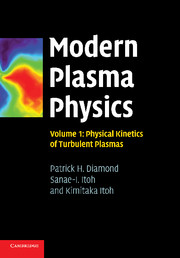Book contents
- Frontmatter
- Contents
- Preface
- Acknowledgements
- 1 Introduction
- 2 Conceptual foundations
- 3 Quasi-linear theory
- 4 Nonlinear wave–particle interaction
- 5 Kinetics of nonlinear wave–wave interaction
- 6 Closure theory
- 7 Disparate scale interactions
- 8 Cascades, structures and transport in phase space turbulence
- 9 MHD turbulence
- Appendix 1 Charney–Hasegawa–Mima equation
- Appendix 2 Nomenclature
- References
- Index
6 - Closure theory
Published online by Cambridge University Press: 05 October 2010
- Frontmatter
- Contents
- Preface
- Acknowledgements
- 1 Introduction
- 2 Conceptual foundations
- 3 Quasi-linear theory
- 4 Nonlinear wave–particle interaction
- 5 Kinetics of nonlinear wave–wave interaction
- 6 Closure theory
- 7 Disparate scale interactions
- 8 Cascades, structures and transport in phase space turbulence
- 9 MHD turbulence
- Appendix 1 Charney–Hasegawa–Mima equation
- Appendix 2 Nomenclature
- References
- Index
Summary
In general, commanding a large number is like commanding a few. It is a question of dividing up the numbers. Fighting with a large number is like fighting with a few. It is a question on configuration and design.
(Sun Tzu, “The Art of War”)Concepts in closure
This chapter discusses closure theory, which is often referred to as strong turbulence theory. The motivation for turbulence theory arises naturally from consideration of weak turbulence theory in the limit where the triad coherence time becomes very long or divergent (i.e. τR,k or Θk,k′,k″ in Chapter 5 goes to infinity), so that the nonlinear transfer is so large as to predict negative spectra. Of course, strong turbulence theory has its own identity as the theoretical description of high Reynolds number Navier–Stokes turbulence and other problems with strong excitation of many degrees of freedom. This suggests that physics other than wave dispersion or (weak) dissipation, upon which we focused in Chapter 5, is controlling the triad coherence time. Intuition suggests that the physics is nonlinear scrambling, which may be thought of as the turbulent mixing of a test mode by advection by the ensemble of turbulence. Such turbulent mixing occurs via an effective eddy viscosity, which is a functional of the turbulent velocity field. The goal of closure theory is to realize this intuition from a systematic, deductive mathematical procedure, in which all approximations are clear ab initio.
- Type
- Chapter
- Information
- Modern Plasma Physics , pp. 208 - 265Publisher: Cambridge University PressPrint publication year: 2010

